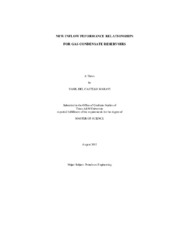| dc.description.abstract | In this work we propose two new Vogel-type Inflow Performance Relations (or IPR) correlations for gas-condensate reservoir systems. One correlation predicts dry gas production the other predicts condensate (liquid) production. These correlations provide a linkage between reservoir rock and fluid properties (dewpoint, temperature, and endpoint relative permeabilities, composition, etc.) to the flowrate-pressure performance for the reservoir system.
The proposed IPR relationships for compositional reservoir systems are based on data from over 3000 compositional reservoir simulation cases developed using various fluid properties and relative perme-ability curves. The resulting IPR curves for gas condensate systems are quadratic in behavior - similar to the Vogel IPR trends (the Vogel (quadratic) rate-pressure profile is generally presumed for the case of a solution gas-drive reservoir system). However, in the case of a gas-condensate reservoir system, the coefficients in the quadratic relationship vary significantly depending on the richness of the gas conden-sate fluid (i.e., the composition) as well as the relative permeability-saturation behavior. Using an alter-nating conditional expectation approach (i.e., non-parametric regression), an approximate model was de-veloped to estimate these coefficients.
This work also includes a discussion of the Vogel IPR for solution gas-drive systems. The original work proposed by Vogel is based on an empirical correlation of numerical simulations for a solution-gas-drive system. Our work provides a critical validation and extension of the Vogel work by establishing a simple, yet rigorous formulation for flowrate-pressure performance in terms of effective permeabilities and pres-sure-dependent fluid properties.
The direct application of this work is to predict the IPR for a given reservoir system directly from rock-fluid properties and fluid properties. This formulation provides a new mechanism that can be used to couple the flowrate and pressure behavior for solution gas-drive systems and we believe that it may be possible to extend the proposed semi-analytical concept to gas-condensate reservoir systems. However, for this work we have only considered a semi-empirical IPR approach (i.e., a data-derived correlation) for the case of gas-condensate reservoir systems. We recognize that further work should be performed in this area, and we encourage future research on the topic of semi-analytical modeling of IPR behavior for gas-condensate reservoir systems. | en |


